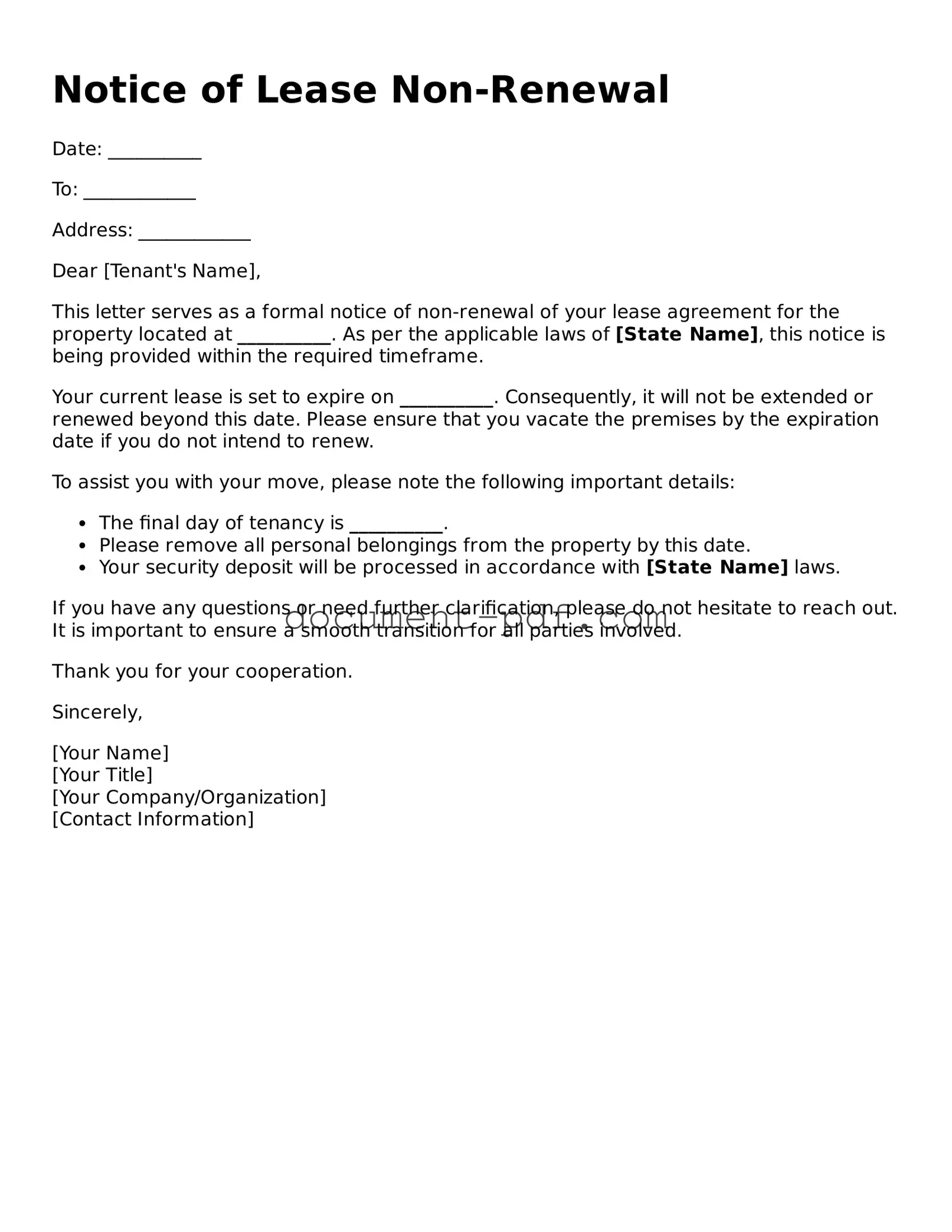The Notice of Lease Non-Renewal form shares similarities with the Lease Termination Notice. Both documents serve as formal notifications to tenants regarding the end of a lease agreement. A Lease Termination Notice can be issued by either the landlord or the tenant, indicating the intention to terminate the lease before its expiration date. Just like the Notice of Lease Non-Renewal, this document outlines the reasons for termination, the effective date, and any obligations that need to be fulfilled by either party before the lease officially ends.
Another document that resembles the Notice of Lease Non-Renewal is the Eviction Notice. While the Notice of Lease Non-Renewal is often issued when a lease is expiring, an Eviction Notice is typically used when a tenant has violated lease terms. Both documents require clear communication of the intent to end the tenant's occupancy, but the Eviction Notice may involve more urgency and legal implications. It often specifies the grounds for eviction, the timeframe for the tenant to vacate, and any potential legal actions that may follow if the tenant does not comply.
Understanding the intricacies of rental agreements, such as the Notice of Lease Non-Renewal and various other forms, is crucial for both landlords and tenants to ensure smooth transitions. For those looking to familiarize themselves with lease documentation, valuable resources are available, including the UsaLawDocs.com, which provides essential information and templates for California lease agreements.
The Move-Out Notice is also akin to the Notice of Lease Non-Renewal. This document is provided by tenants to inform landlords of their intention to vacate the premises. Similar to the non-renewal notice, the Move-Out Notice includes the intended move-out date and may outline any conditions related to the return of the security deposit. Both documents emphasize the importance of clear communication between landlords and tenants regarding the end of occupancy.
A Notice to Vacate is another document that parallels the Notice of Lease Non-Renewal. This notice is often issued by landlords to inform tenants that they must vacate the property by a specific date. Like the non-renewal notice, the Notice to Vacate outlines the timeframe for moving out and may include reasons for the request. Both documents aim to ensure that tenants are aware of their need to leave the property, albeit for different circumstances.
The Rental Agreement Amendment also has similarities with the Notice of Lease Non-Renewal. While the non-renewal notice indicates the end of an existing lease, an amendment modifies the terms of an ongoing rental agreement. Both documents require clear communication and agreement between the landlord and tenant. An amendment might extend the lease duration or change rental terms, while the non-renewal notice signals that no further agreement will be made.
The Lease Renewal Agreement is another document that can be compared to the Notice of Lease Non-Renewal. This agreement is used when both parties agree to extend the lease for another term. While the non-renewal notice indicates that the lease will not continue, the renewal agreement outlines new terms and conditions for the ongoing relationship. Both documents reflect the decisions made by landlords and tenants regarding the future of their rental arrangement.
Lastly, the Sublease Agreement shares some characteristics with the Notice of Lease Non-Renewal. A sublease agreement allows a tenant to rent out their leased space to another party, often during the original lease term. While the non-renewal notice addresses the end of a lease, both documents require the consent of the landlord and clear communication about the terms of occupancy. Each document reflects the tenants' responsibilities and the landlord's rights in managing the property.
